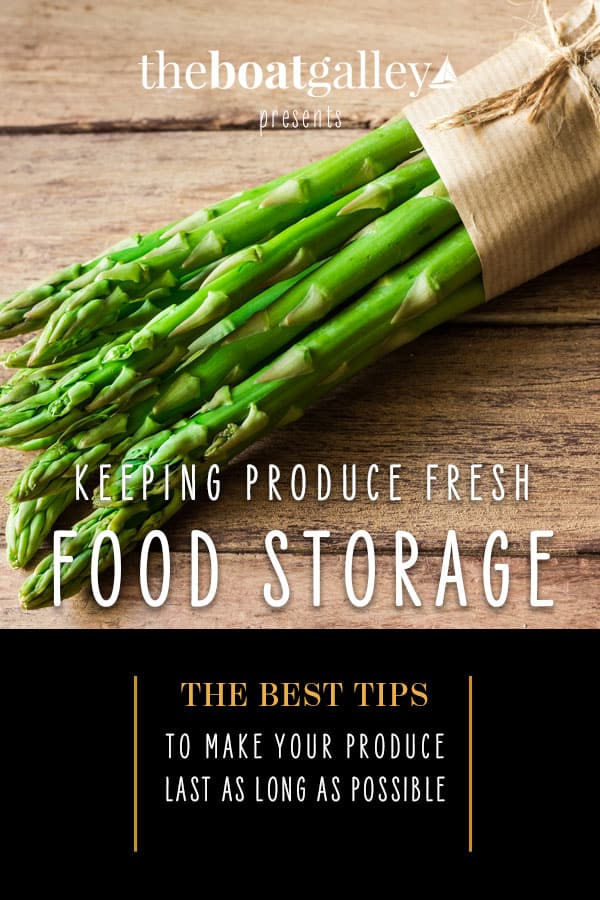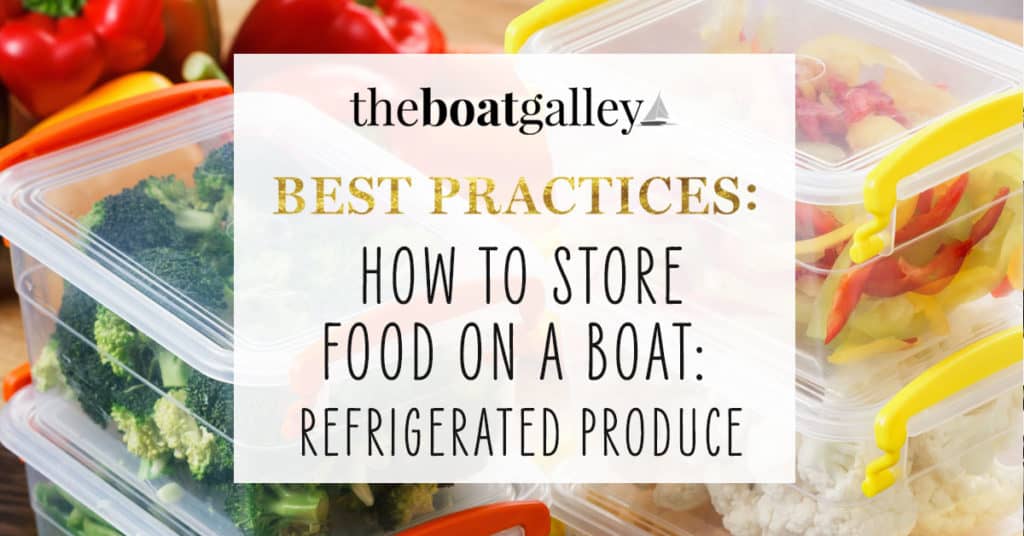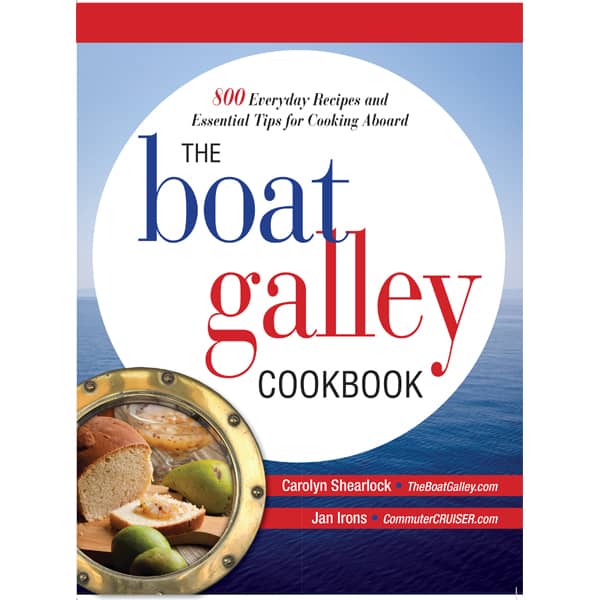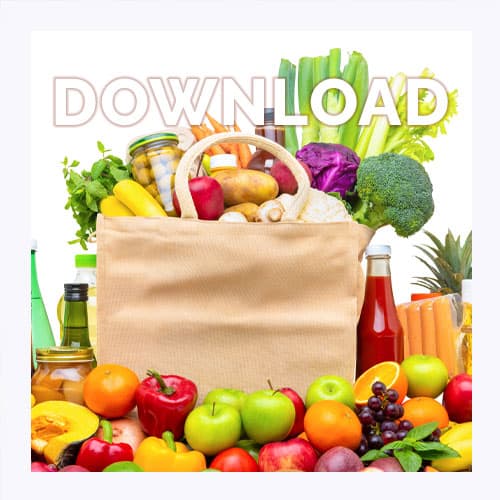
How do you store produce on a boat? Where home refrigerators have all sorts of wonderful produce bins, complete with directions on what to put where, you have to develop your own system in a boat refrigerator. Add in that your boat refrigerator is likely to be much smaller than one ashore, and the questions mount.
Don’t worry. Here’s how to store produce on a boat.
Wash the Produce
We get really spoiled with the produce we buy in US supermarkets: almost all of it has been washed long before we buy it. Much of it is even labeled “pre-washed — ready to use.” But if you’re outside the US — or buy your fruits and vegetables at a farmer’s market or roadside stand — the first step in storing your produce is to wash and dry it.
In washing the produce, you’re doing two things: getting the dirt off, and getting rid of any germs and bacteria.
As described in Avoiding Critters, use one capful of bleach (plain, no fancy scent) in one to two gallons of water and swish your produce around in it. For tough, dirty items like carrots, use a vegetable brush to scrub the dirt off.
The produce must be dry before you put it into the refrigerator. If it’s warm, you may just be able to lay the produce on some towels for a half hour or so. On cooler days, it can pay to aim a fan at the produce to improve airflow. You can change towels periodically and even blot the water off. But if the produce is still damp, it will rot much more quickly in the refrigerator.
Store Some Produce Out of the Refrigerator
Make room for things that really do better in the refrigerator — lettuce and berries, for two — by storing as much produce as reasonable outside the refrigerator. Things like tomatoes, green onions, oranges and more do just as well — if not better — out of the fridge. Check out my course Eating Well With A Tiny Fridge, which includes my book Storing Food Without Refrigeration for step-by-step details on how to store a wide variety of fruit and vegetables outside the refrigerator.
The Condensation Problem
In tropical areas — particularly in the summer — one of the biggest problems you’re likely to face in storing produce is condensation. If you put room temperature carrots, say, into a plastic bag and then put that plastic bag into the refrigerator, all the moisture in that warm, humid air inside the bag is going to condense in the bag. And your carrots are going to sit in that water, and begin to lose their texture and quickly rot.
I tried using those green refrigerator bags, and while they may prolong the life of vegetables for some, they didn’t solve the condensation problem.
I did find two solutions to the problem — one cheap but more labor-intensive, and one costing more but no work on a day-to-day basis:
- Cheap: Wrap a double layer of paper towels around vegetables before putting them in a plastic bag, and then change the paper towels every day (hang the wet paper towels to dry, then use them again the following day). As explained to me by Erin on Ballena, who taught me this trick in our first year: “The paper towel acts as a little diaper so there’s no puddle of water.”
- Less work: Rubbermaid has come out with a line of Produce Saver food storage containers. They have a vent in the lid for air circulation and, more importantly for me, a tray in the bottom to keep the contents out of any accumulated moisture. They’re available both in sets of four (one 14-cup, one 5-cup and two 2-cup containers) and individually. The last time I checked (and things can change by the minute) — it was cheaper to get the set of four than just one 14-cup container.
The Produce Saver containers have the added advantage of protecting their contents a little better from the motion of the boat, but they take up more room in the refrigerator. Also, they have to sit on their bottoms — not be wedged in on their sides or ends — to work. The typical motion of the boat doesn’t get the produce wet, however. Take up any extra space inside the containers with bubble wrap or paper towels to protect the contents from bruising.
UPDATE: Somewhat contrary to the above, about 6 weeks after posting this, I learned a trick for storing celery: if you tightly wrap celery in aluminum foil before putting it in the refrigerator, it will stay crisp for several weeks. Apparently, celery loses its crispness as it loses its moisture. And for some reason, it retains its moisture — and hence its crispness — much better when wrapped in foil than in a plastic bag.
Storage Bins
You don’t just want to chuck your bags or boxes of produce in with all the drink cans and so on. Produce needs it’s own bin(s), where it can be protected from bruising with the motion of the boat.
Most produce wants only to be kept cool, not cold or frozen. This is particularly true of leafy vegetables, but tomatoes, peppers, berries, fruits, and squash — just to name a few — lose texture if they get too cold.
Consequently, never put produce into metal containers — they conduct too much cold. Instead, use soft plastic containers — they conduct less cold than hard plastic. I prefer solid bins — ones that are milk crate style or that have holes in the bottom or sides are more likely to bruise produce. And again, use a bunch of bubble wrap to take up extra space.
I like to put “fragile” foods into their own containers. Things like tomatoes, peaches, and strawberries are just too liable to get squashed if not in their own hard-sided container. For example, I took a gallon water bottle and cut the top off, then wrapped tomatoes individually in bubble wrap and packed them in. Protection against bruising really extends the life of produce on a cruising boat as bruises quickly turn to rot. I found that I had more usable produce by not trying to pack so much into the space available!
Put the Bins in the Warmest Places
By now, you’ve already figured out that your produce bins should go in the warmest places in your boat refrigerator. My refrigerator area was fairly deep (okay, when I was wiping out the bottom during defrosting, my feet were off the floor), so this meant that I could stack bins two deep. Since cold air falls and hot air rises, my produce bins were the top layer. If you have enough depth, this is perfect — if they’re on top, nothing will fall into them and cause bruising.

Carolyn Shearlock has lived aboard full-time for 17 years, splitting her time between a Tayana 37 monohull and a Gemini 105 catamaran. She’s cruised over 14,000 miles, from Pacific Mexico and Central America to Florida and the Bahamas, gaining firsthand experience with the joys and challenges of life on the water.
Through The Boat Galley, Carolyn has helped thousands of people explore, prepare for, and enjoy life afloat. She shares her expertise as an instructor at Cruisers University, in leading boating publications, and through her bestselling book, The Boat Galley Cookbook. She is passionate about helping others embark on their liveaboard journey—making life on the water simpler, safer, and more enjoyable.
Simplify meal prep on board with proven strategies for provisioning, maximizing fridge space, and cooking delicious meals aboard your boat.










Danielle says
Carolyn, what is your opinion on “Green Bags”? I’ve heard people swear by them, but not necessarily in a boat setting. Have you used these, or heard of people using them while cruising?
Carolyn Shearlock says
Danielle —
I didn’t have any luck with them at all . . . but it was 5+ years ago when they were brand new and they may have improved now. I have several friends who use them and love them — in fact, I’ve just come back from 3 days out with a friend (Jan, who I’m writing the cookbook with) and she swears by them.
Carolyn
Dawn Rodney says
Hi Carolyn,
I have been experimenting with produce bins but haven’t found exactly what I am looking for. Do you have any pictures or recommendations for a particular brand or type of produce container?
Thanks,
Dawn
Carolyn Shearlock says
Hi Dawn!
My absolute favorites (at least so far . . .) are the Sterilite ventilated bins — they have solid bottoms, so no little wires cutting into the produce and if something does rot, it’s contained and the plastic is easy to clean. The bins are quite sturdy, and come in a wide variety of sizes, making it possible to find ones that would fit in various lockers and refrigerator configurations.
I use these for lots of purposes, not just produce — they make good bins for storing smaller items in lockers (think spice packets, nuts packages and so on) and work well as refrigerator bins for drinks. You can see them in action filled with produce in a cooler.
I’ve tried solid bins (not enough air circulation), wire bins (wires cut into food, causing bruising and rot), milk crates (food falls out the large holes in the bottom, the plastic “bars” can cause bruising and they are too large for many locations). If you have to use wire bins or milk crate-type bins (particularly in foreign countries, sometimes you have to take what you can find), line them with some fleece or a towel to pad the produce.
The Sterilite bins are available at Walmart and other big-box stores as well as at Amazon.
-Carolyn
Elly says
I use the green bags and love them. The longest I have kept veg in them is 3 weeks and it looked as fresh as the day I bought the produce. The only thing you have to do is to remove the condensation as you go along. I remove most of it with by wiping a paper towel around while the produce is still in the bag.
Lorraine D. says
I found that wrapping tomatoes, cabbage and other fruit in newspaper and then putting them in netting hammocks really help produce last a long time. Like Celery, I wrapped my carrots in aluminum foil and they lasted a long time in the hammock.
Lorraine
Monica McKaskle says
Citrus in aluminum foil will double the life as well (doesn’t have to be refrigerated). I, too wrap my cabbage in paper, but found that if they’re touching any other food (or each other), they rot quicker.
Belinda Bacon-Reinagel Wolfe says
I have had pretty good results in my cold plate refrig with the BLUE APPLE. It absorbs the ethylene gas that produce emits and causes them to ripen.
The Boat Galley says
Thanks! I just ordered them. Look for a post in a couple of weeks after I try them out
Monique Davis says
Ever since I read that storing apples and potatoes together helps keep them both fresh I’ve been doing just that and, would you believe, I still have some apples that we bought almost three months ago. They are just starting to get a little special (I’m sensing an apple curry in our future), but it’s been a life saver.
I also have a cloth produce bag where I keep my mushrooms. The cloth soaks up any moisture and keeps the mushrooms from becoming slimy and rotting. I’ve also used a paper bag in a pinch, but it tends to rip in our washing machine of a fridge.
Kathe Spidell says
Cabbage will keep forever in the fridge in wrapped in foil. Cut off the dark before re wrapping. It has lasted months.
Also, the nifty Sterilite ventilated bins are great. I am having clear durable plexiglass covers made to place on top, so I can stack them in my fridge, so I won’t bruise up my produce.
Michelle Rene says
Excellent info
Patti H says
We had space and the power to run an Engle for produce- runs on a very low level and keeps all our fresh stuff in good shape for a long time.
Maria says
I use Freshpaper. Link is to get it on Amazon.
Becky says
I bought the yellow produce storage bags recently, and found that they keep romane lettuce longer, but put tomatoes in one, and those turned rotten so fast, it was horrible!!!
Kelly s/v Sunsets says
I always had a problem keeping my fruits and veggies from freezing in my top-load fridge. I started putting them in one of those padded insulated shopping bags (with a zipper on top). That seems to keep the produce cool but insulates it against freezing.
WANITA Meed says
I always bought potatoes with thicker skins and didn’t wash them. Same as any root vegetable, just brushed off the heavy dirt. In Brazil, I bought light coloured, thin skinned potatoes and they went bad really quickly as we sailed north to Caribbean.